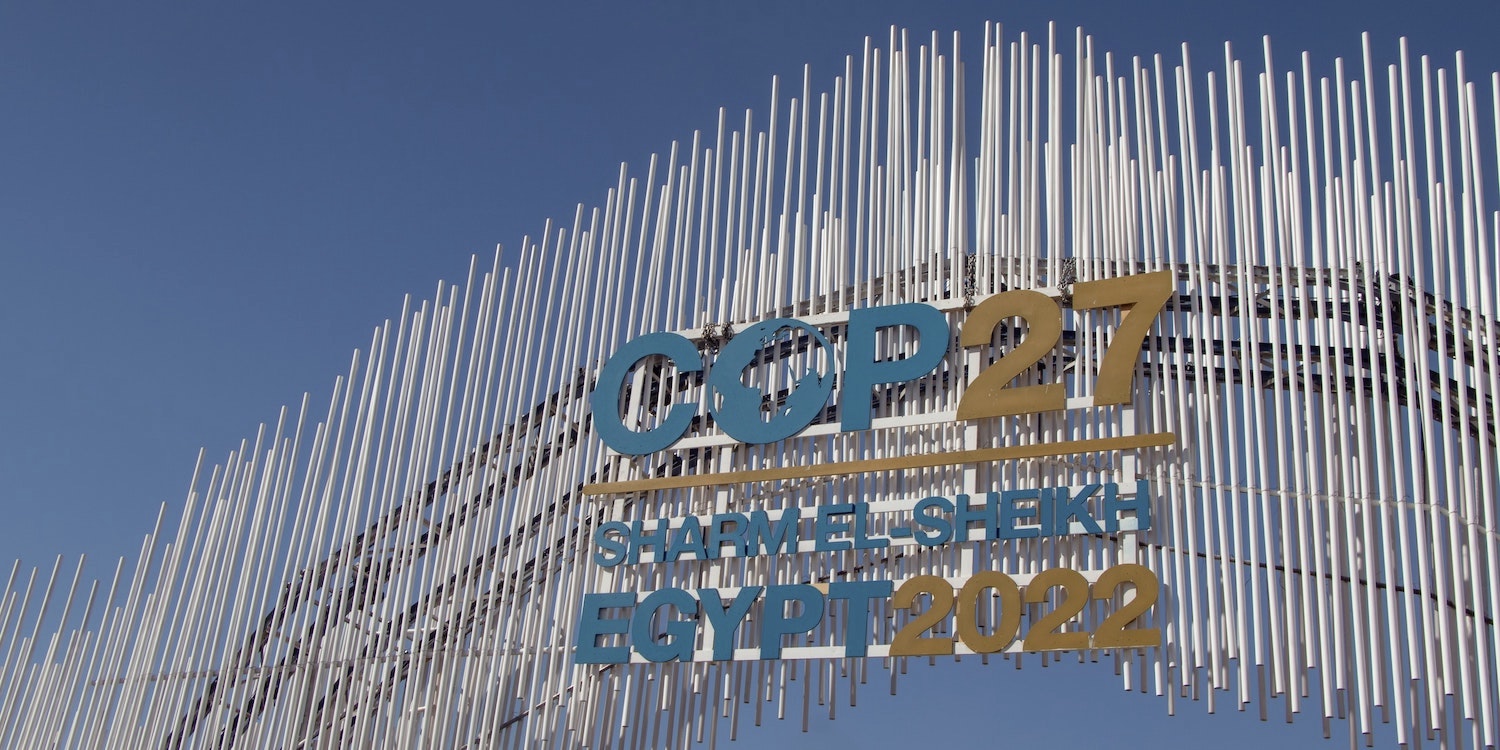A sweltering Egypt welcomed attendees to COP27 last month, which must have felt, in a way, ironic.
The COP (which stands for Conference of the Parties) happens once a year over the course of two weeks. During that time, leaders, delegates, activists, and representatives take part in negotiations, events, press conferences, and more. There were an estimated 35,000 to 46,000 people who attended this year. It was the 27th meeting of the parties.
From COP26 to 27, little has changed in the way of combating climate change when it comes to world-wide government intervention. If this is your first time hearing about the COP, our blog post from last year is a great place to start to get a base-level understanding of what takes place at each event.
This year’s theme was Uniting the World to Tackle Climate Change. Here are the key takeaways, including some wins, some losses, and opportunities for future COPs to do better.
The Good: Progress for the Loss and Damage Fund, and a Stage for Indigenous People
Last year we wrote that we needed to see, “wealthier, high-greenhouse gas emitting countries to pay reparations to countries greatly affected by global warming who emit little to no greenhouse gasses.”
We’re happy to share this year, the COP took a step in a definitive direction to make that happen!
Countries debated and voted on creating the Loss and Damage Fund for the countries most deeply harmed by climate change and passed the fund. This is huge, as many wealthier countries aren’t interested in being held liable for climate damages. The United States was one of the countries that agreed to support the funds.
Unfortunately, the “who” when it comes to paying the funds and “how” were punted until COP28 despite pressures to sort out the details and begin assisting those in need, like Caribbean and African countries. 24 countries will spend the next year trying to sort out the details so the Loss and Damage Fund can move forward supporting struggling countries after COP28.
These funds are specifically for climate catastrophes. They don’t include helping developing nations make investments in more sustainable energy options.
One estimate claimed developing countries could need close to $2 trillion per year by 2030 to address climate change between infrastructure and damage. The damages taking place include rising sea levels, heatwaves, bushfires, species extinction and the desertification and infertility of land.
For countries experiencing the brunt of climate change with little to no emissions – this is a huge, much deserved win. But, for countries who have been emitting greenhouse gasses and causing devastating situations, this wasn’t an aggressive enough decision.
In fact, many criticized the “win” as not being radical enough. A viral photo circulated the internet showing countries responsible for climate change have emitted more greenhouse gasses than they’ve paid in climate change reparations.
Another win was that the diversity improved some at this COP compared to the last. Yet, those in power are still widely white, older men from wealthier nations. Women of color from less wealthy nations were still those pushing for change and radical action.
COP27 included an Indigenous people’s stage that allowed first nation individuals to share their struggles and recommendations. Many mentioned difficulty when it comes to receiving funding for land stewardship. It’s important to include Indigenous groups more intentionally in the future, and to look to them for climate resolutions.
The group ended the conference by recommitting to 1.5 degrees celcius target goal. While it’s good that the world is still committing to this goal, another year of just the commitment is actually bad news.
Mostly because said commitment doesn’t provide any tangible, radical steps to get us there.
The Bad: We’re No Closer to Avoiding our 1.5 Degrees Celsius Increase
The Loss and Damage Fund is the bandaid over the top of the flesh splitting cut that fossil fuels are making to the planet over and over again. It is a reactive measure, rather than a proactive one.
This is to say the COP took coal restrictions firmly into their hands while letting oil and gas restrictions slip through their fingers.
From the beginning of the conference, Egypt took a stance that their role was to create a space where negotiations could take place. They claimed to be “moderators”. Some suggest this is a reason why the COP made little to no headway compared to last year’s event.
This COP saw a wide range of oil and gas representatives in attendance.
China and Saudi Arabia blocked phasing out all fossil fuels. And, the language used currently reads as a, “phasedown of unabated coal power and phase-out of inefficient fossil fuel subsidies.” Many argue this language isn't strong enough to drive actual change away from using fossil fuels.
The Russian Invasion of Ukraine has made the oil and gas debate especially complicated. New sanctions on Russia have provided an opportunity for other countries to reap financial benefits by producing oil and gas.
Ultimately, because countries were unable to come together and make a plan to phase out all fossil fuels (rather than coal), they’re essentially signing up for the damage they’re planning to do and will have to pay for in the Loss and Damage Fund.
It’s discouraging and a senseless.
The Ugly: Egypt Subdues Protestors and Serves Up Meat
Another hard truth learned at the COP is that where the COP takes place matters. In Egypt, climate protesters, who attend all COPs were corralled, harassed, intimidated, and monitored by the Egyptian government. Many climate activists weren’t even allowed in the country and were turned away when they arrived in Egypt.
In the past years, the COP has provided attendees with many vegan and vegetarian meal options. This year’s event included salmon, beef, and other seafood options – much to the criticism of the vegan community. Meat and dairy create a much more significant carbon footprint compared to local fruits and vegetables.
And, the ugly continues. COP28 will be held in the United Arab Emirates next year, another company that largely depends on petroleum exports for its economy. They will likely heavily lobby to keep the COP from banning all fossil fuels. So, we’re likely in for another year of disappointment and vague, lackluster goals.
You can see a full list of where the COP conferences will take place in the future here.
COP27 is Over, Now What?
A notable moment came when a representative from Ghana handed a mic to 10-year-old Nakeeyat Dramani Sam, also from Ghana. Nakeeyat scolded delegates, telling them they would “act faster to end climate change if they were her age.”
A fair statement given how long negotiations had gone over and how little progress has happened in the way of climate mitigation after 27 years of meeting.
Today, we’re still holding onto this statement. What age are we, as an organization, and as individuals, acting? Are we addressing climate change with the urgency of a ten year old who has their whole life ahead of them?
Or are we acting like a sixty-something year old world leader who’s afraid of change and likely won’t be alive for 2050?
Sadly, the action to take post COP27 is similar to COP26. Despite that news being discouraging, it’s still worth the fight. We can all play our part in taking the next steps to mitigate and avoid climate change.
Consider your location and privilege. If you live in a country that is one of the main greenhouse gas contributors, it’s time to get involved.
Own your footprint. We’re not saying everyone has to live a zero waste lifestyle tomorrow. But the impact of cutting one single use item out of your life can make a huge difference over time.
Continue to invest in zero-waste alternatives until there’s little to nothing that you use that’s single use. And, don’t forget to look for big opportunities, like adding solar panels to your home or purchasing an EV.
Vote for decision makers that care about climate change. Midterms in the US are over, which means we have a major election in two years. What bills are going to affect your community? How can you make the most of your voice on a local and national level? What leaders champion climate solutions?
Hold major carbon emitting companies accountable. 100 companies are responsible for 70% of the carbon emissions. Boycotting, lobbying, or applying pressure on these major organizations can drive change.
Our planet is worth fighting for. We’re in this with you.






